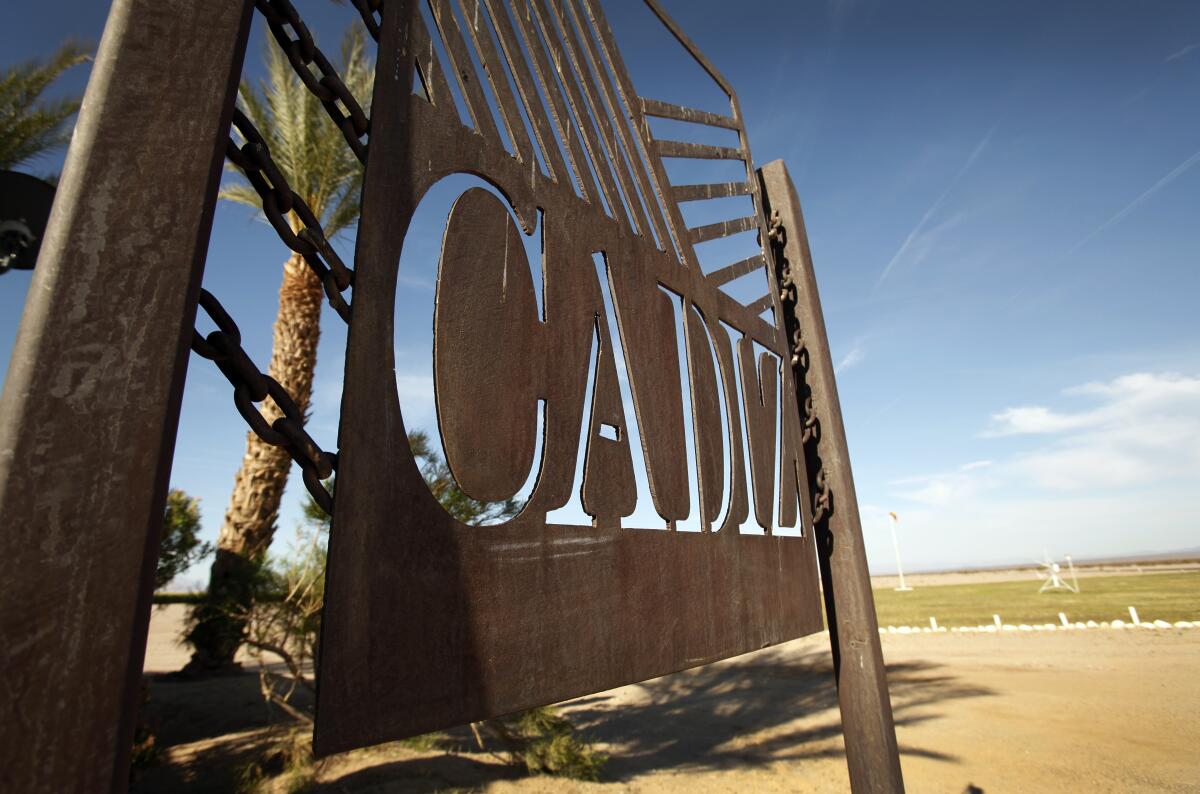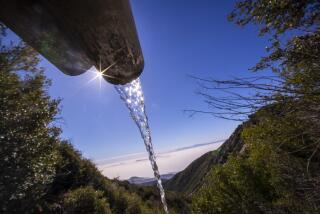Column: Has Biden moved to finally kill California’s most farcical water project?

- Share via
Desperation over water scarcity has produced any number of schemes to relieve the crisis. But few are as chuckleheaded as a plan to pump groundwater from beneath the Mojave Desert and transport it 200 miles to urban Southern California.
This is the Cadiz water project, which has been percolating since the turn of the century.
I’ve been following this scheme almost since its inception, starting with an investigative article in 2002 that made the case for the Metropolitan Water District of Southern California to bail on a proposed partnership with its promoter, Cadiz Inc. The MWD did so, which should have killed the plan.
This is not a case where BLM conducted an appropriate level of analysis, in which the court might find some technical legal errors. Instead, BLM failed to prepare the required analyses altogether.”
— Bureau of Land Management calls foul on itself
But it has continued to stalk water policy ever since. Now, finally, the Biden administration may have driven a stake through its heart for good.
Get the latest from Michael Hiltzik
Commentary on economics and more from a Pulitzer Prize winner.
You may occasionally receive promotional content from the Los Angeles Times.
On Friday, officials at Biden’s Interior Department petitioned a federal judge to throw out project approvals issued in 2020 by the same agency under President Trump; a hearing on the petition is set for March. More on that in a moment.
Even if Cadiz is killed, the problem of ill-conceived solutions to water scarcity won’t go away. The best illustration of how desperation affects water policy is the More Water Now ballot initiative, which I described a few days ago as a dangerously ill-conceived measure. The proposal’s backers are now collecting signatures to place it on the November 2022 ballot.
The Cadiz plan is, if possible, even worse. The proposal has remained alive up to now not because it has any practical value. It doesn’t.
As I wrote in 2009, the plan always “had a sort of shimmering authenticity, like a desert mirage.” But it didn’t bear close inspection.
As proposed by Cadiz Inc., the idea was to store surplus Colorado River water under a desert tract owned by the company, pump it out during dry spells and transport it by pipeline or canal to Southern California urban users.
Among the problems is that there isn’t any surplus water in the Colorado. The basin is in a long-term drought, and for the foreseeable future California will be lucky to get its full statutory apportionment of river water. A single extra drop? Forget it.
Furthermore, there’s considerable disagreement over how much groundwater really underlies the Cadiz land, not to mention how much the company is legally permitted to pump out and how much could be pumped before neighboring aquifers become contaminated with carcinogenic minerals.
When President Trump nominated David Bernhardt for a top-level post at the Interior Department, environmentalists and water experts could see trouble ahead.
The U.S. Geological Survey has calculated that the company’s estimates of the available water for pumping were roughly seven times as high as what was reasonable.
Then there’s the difficulty of transporting the water, which would require pipelines crossing delicate desert ecosystems.
No, what has kept the scheme alive has been political pull. This was exerted chiefly by Cadiz’s conceiver, an investment promoter named Keith Brackpool, who — as I reported in 2002 — came to the U.S. after pleading guilty to criminal charges relating to securities trading in Britain.
While he was pushing the deal at the MWD, Brackpool served as a contributor and fundraiser for then-Gov. Gray Davis, a political adversary of the MWD who named his friend to two statewide water committees. “The thinking was: You make a deal with Keith Brackpool, and you’re on the good side of Gray Davis,” a former MWD board member told me in 2002.
Former Rep. Tony Coelho of California, an important Democratic Party fundraiser, served on the Cadiz board. Former Interior Secretary Bruce Babbitt, a former Democratic governor of Arizona, joined its payroll to work on international water deals, none of which came off.
In 2005, the company paid then-Public Utilities Commissioner Susan Kennedy, soon to become Gov. Arnold Schwarzenegger’s chief of staff, a $120,000 consulting fee. In 2009, while Kennedy was working for Schwarzenegger, he endorsed the Cadiz scheme as “a path-breaking, new, sustainable groundwater conservation and storage project.”
Brackpool hobnobbed with former Los Angeles Mayor Antonio Villaraigosa, contributing to his political campaigns, giving him a job between electoral posts and joining him on an East Asia trade junket.
Despite all that, the project kept running into roadblocks, in part because of the opposition of Sen. Dianne Feinstein (D-Calif.), who was determined to protect the desert ecology. Cadiz also has faced lawsuits from environmental groups, as well as adverse rulings by the Bureau of Land Management, an arm of the Interior Department with oversight of federal lands, including those the proposed pipelines would cross.
It was obvious even during the presidential campaign that Donald Trump didn’t know much about water policy and didn’t have much inclination to learn.
Enter the project’s most recent patron: Donald Trump’s Interior secretary, David Bernhardt, one of several Cabinet secretaries Trump put in place with the evident purpose of undermining the agencies they were supposed to run.
Bernhardt came to the Interior Department from the law firm Brownstein Hyatt Farber Schreck, which represented a sheaf of clients in the natural resources industry that had paid the firm “millions of dollars in legal and lobbying fees,” as my colleague Bettina Boxall reported. (Among Bernhardt’s goals at Interior was the evisceration of the Endangered Species Act, a bête noire of some of those clients.)
Cadiz had paid the Brownstein firm $2.75 million in lobbying fees and 200,000 shares of stock while Bernhardt was there. One of Bernhardt’s partners at the firm, Scott Slater, serves as the Cadiz chief executive. Bernhardt is now back at the firm, serving as a senior counsel in its Washington office.
When Bernhardt was initially appointed as deputy Interior secretary in August 2017, he committed to recusing himself from matters related to those clients for one year after his appointment, which ran out in mid-2018. He was nominated to the top job in February 2019, succeeding Ryan Zinke. The BLM decision now being disavowed by the agency came in December 2020.
During all this time, Cadiz has been notable chiefly as a stock-trading device, rather than as an operating company. In 2020, Cadiz Inc. lost $37.8 million on revenue of $541,000, mostly from some agricultural operations on its land holdings. From 2017 through last year, its losses came to $127.5 million. The company says its future is tied up with the “ultimate implementation of the Water Project.”
Let us today hoist a glass -- preferably of cool, clean Colorado River water -- to Keith Brackpool, a walking illustration of how the generous bestowal of campaign donations and other largess can keep a man cozy with California politicians, even in the face of evidence that what he’s selling may not be worth buying.
Meanwhile, Brackpool has continued to pull down an annual salary of $275,000, plus bonuses ranging from $200,000 to $300,000 and stock awards. Slater received $600,000 in salary and bonus last year, plus about 198,000 shares of stock.
The company’s share price doesn’t seem to be associated with any actual business performance, since for the most part it doesn’t have much of that. Indeed, after the price slid by about 35% from $14.55 on Aug. 17 to $9.42 on Sept. 13, Cadiz issued a news release stating that it couldn’t explain the activity, as there had been “no new material developments nor pending announcements.” On Tuesday, the shares closed at $4.18.
That brings us back to the government’s court petition.
In historical terms, it may be unusual for a federal agency to ask a judge to reverse its own prior actions. That’s been happening with some regularity this year because Trump worked so assiduously to subvert established regulations.
The specific issue raised in the BLM petition was the agency’s approval for Cadiz to convert an old 200-mile natural gas pipe right of way to carry water across the desert. Under Trump and Bernhardt, BLM came up with a series of excuses to avoid performing an environmental analysis required by federal law, the agency now says.
In their court petition, the current BLM officials charitably stop short of calling their predecessors’ prior approval dishonest. They settle, instead, for advising the court it was incompetent, erroneous and illegal.
“This is not a case where BLM conducted an appropriate level of analysis, in which the court might find some technical legal errors,” they wrote. “Instead, BLM failed to prepare the required analyses altogether.”
Most egregiously, they observed, Trump’s BLM approved the pipeline right of way without establishing the source of Cadiz’s water; therefore it could not have assessed “the potential impacts on the environment or historic properties of drawing down the water at its source.”
Cadiz water deal was all wet the last time
Cadiz said Sunday that it will fight in court to preserve the old BLM approvals and that the process of converting the pipeline for water will continue in the meantime.
The company continues to exploit the California drought to push a project that experts have long held to be useless as a drought-fighting measure.
Last week, after state water authorities advised Central Valley farmers that they shouldn’t expect any water next year from the State Water Project, Cadiz issued a statement calling the pipeline plan “an immediate opportunity” to address “supply inequalities and infrastructure challenges.”
Never mind that completion of the pipeline is probably years away, if it ever happens at all. The company acknowledges that building the water project will require additional capital, which it can’t be sure of raising.
The Cadiz plan was never likely to work, and notwithstanding the company’s claims about the current drought, it’s more fatuous today than ever. It’s time to bury it in the desert grave where it belongs, and with any luck, the BLM’s new court filing will finish a long-overdue job.
More to Read
Get the latest from Michael Hiltzik
Commentary on economics and more from a Pulitzer Prize winner.
You may occasionally receive promotional content from the Los Angeles Times.











